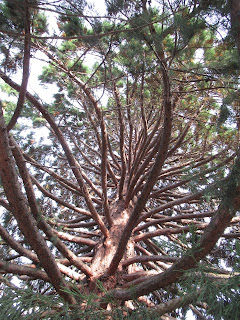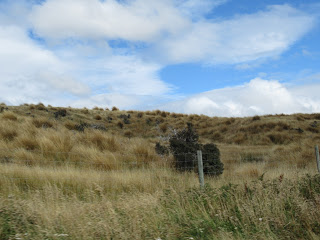I am simultaneously finishing a travel blog about the fantastic 4.5 month long trip Steven and I took last fall to Armenia, Georgia, Azerbaijan, much of Central Asia and then the final six weeks in Spain and Portugal. If you're interested in checking that exciting adventure out, here's the link:
Diane and I'd seen several skate parks already in New Zealand but none were as large as this one.
I took this photo of a time capsule that had been placed in this spot but forgot to write down when it'd been put there and also when it will be unveiled. I just used two magnifying glasses to try and see the dates but wasn't able to so googled it and found out it'll be reopened on the city's 150th anniversary in 2090. Thanks, Google!
Elizabeth Hall's 2001 sculpture was titled Fleur or Flower which was certainly an apt choice for a botanical garden.
It was neat seeing how the Queenstown Lion Club had prepared packets of duck food for children to feed the ducks through the park. Adults were asked to place the $2 cost in a clay duck on a table on a honor system.
Before leaving Queenstown for what we'd planned would be the last time (until the tragic events in Christchurch several days later changed that) we headed over to the Historic Shotover Bridge located about seven miles from Queenstown. Only open for pedestrian and bicycle traffic, the bridge replaced the wooden bridge built for horse teams and wagons in the early years of the last century.
From the bridge we had panoramic views of the shallow waters of the Shotover River named by pioneer run holder William Rees after Shotover House in England. It was one of the richest gold-bearing rivers in the world.
Leaving Queenstown we began driving south on the Southern Scenic Route, passing the beautiful Lake Wakatipu on the way. There were lots of turnouts to take advantage of the spectacular scenery. We didn't mind in the least knowing we'd be retracing this same drive tomorrow on our way back north again after taking a cruise on the Milford Sound as we figured we'd just be able to see more glorious views from another perspective.


www.bergersadventures6.blogspot.com
Diane and I had a longish drive ahead of us to Te Anau but decided to spend some time that morning wandering around Queenstown Gardens, the botanical gardens which contained a variety of exotic and native trees. It was a beautiful and tranquil place away from the craziness of New Zealand's self-proclaimed adventure capital.
Diane and I had a longish drive ahead of us to Te Anau but decided to spend some time that morning wandering around Queenstown Gardens, the botanical gardens which contained a variety of exotic and native trees. It was a beautiful and tranquil place away from the craziness of New Zealand's self-proclaimed adventure capital.
Diane and I'd seen several skate parks already in New Zealand but none were as large as this one.
I took this photo of a time capsule that had been placed in this spot but forgot to write down when it'd been put there and also when it will be unveiled. I just used two magnifying glasses to try and see the dates but wasn't able to so googled it and found out it'll be reopened on the city's 150th anniversary in 2090. Thanks, Google!
It was neat seeing how the Queenstown Lion Club had prepared packets of duck food for children to feed the ducks through the park. Adults were asked to place the $2 cost in a clay duck on a table on a honor system.
Before leaving Queenstown for what we'd planned would be the last time (until the tragic events in Christchurch several days later changed that) we headed over to the Historic Shotover Bridge located about seven miles from Queenstown. Only open for pedestrian and bicycle traffic, the bridge replaced the wooden bridge built for horse teams and wagons in the early years of the last century.
From the bridge we had panoramic views of the shallow waters of the Shotover River named by pioneer run holder William Rees after Shotover House in England. It was one of the richest gold-bearing rivers in the world.
The bridge was also a viewing platform for the thrilling commercial jet boat trips that pass underneath. We saw one but I wasn't fast enough with my camera to take a photo as it whizzed by. IF Steven and I ever return to New Zealand - something that I never dreamed might be a possibility until a week or so ago - I think we'd have a blast taking one of the jet boat tours along the river.
The bridge was the starting point for one of the many paths that comprise the excellent Queenstown Trail system. Diane and I didn't have a long time to hike but we wanted to take advantage of being out in the fresh air and get some exercise before being cooped up in a car for the next few hours.
This was the first port-a-potty I'd seen that had its own inside sink and window you could open and close. Pretty swish, I thought! Attached to it was a bike air hose, another first.
Diane and I both joked how we wished farmers the world over would place signs by their fields to identify their crops as neither of us could ID anything but corn and hay!
In all of our long drives through so much of the South Island, I never grew tired of the countless sheep pastures we passed. We see them so rarely here in the US or when we travel in Canada that they remained a delight, time after time.
One of the iconic sights traveling through both the North and South Islands were massive hedges, the likes of which I'd never seen before.
Bales of hay were also a common sight in the southwest part of the South Island.
Guess you can figure out those little white flecks were more sheep, right?!
I wondered what caused the ruts in the hills, especially the zigzag ones in the second photo as they didn't appear to be natural.
The clumps of what I would normally have called grass were called tussocks in New Zealand and covered a huge swath of the countryside.
It looked like a golf course but was just extraordinarily green grass or a crop of some sort that we were again unfamiliar with.
Diane and I have seen a lot of mountains in our lives living here in Colorado but these looked very different from the ones back home.
We reached the picturesque town of Te Anau on the southeastern shore of Lake Te Anau in the island's Fiordland region in the early afternoon. The first European explorers, Charles Nairn and William Stephen, saw the lake in 1852. The lake, located 226 meters below sea level, had the largest volume of freshwater in Australasia and was carved out by glacial action.
The lake was still an important area for Maori for its traditional food and natural resources and also where they obtained them. Nowadays, their ongoing cultural, spiritual, historic and physical relationship with the area was officially recognized by the government.
Across the lake, high up in the alpine tussock of the Murcheson Mountains, takahe were once thought to be extinct but they were rediscovered in 1948. As the only place in the world they are found was in Fiordland, their survival was supported by a captive breeding program as well as work controlling introduced predators and deer in their mountain home.
We'd seen so many of these Jucy brand of campervans while traveling throughout New Zealand. Their catchy slogans made Diane and me both smile!

After finding a park in town to eat sandwiches we'd made, we walked along the lakefront and decided to take a cruise later that afternoon across the lake in order to see glowworms in some caves.

According to Maori legend, the mountains of Fiordland were carved out by the great god Tu-te-rakiwhanoa who, starting in the south, hewed the unbroken mountain wall creating the wide southern fiords (yep, that's the way they are spelled in NZ!) and a rugged coastline, leaving many small islands behind him. Where Tu's feet were planted, the land broke away to form the larger Resolution and Secretary Islands.
Cutting into the rock further north, Tu created his greatest work, the steep-sided Milford Sound (our destination very early the next morning), but was called away before he could complete the route inland. He continued his work but created a steep barrier when he reached the head of the Cleddau Valley. Trying again, he carved out the Arthur Valley and the Mackinnon Pass which led to Lake Te Anau. The great lakes, Te Anau and Manapouri, were carved out by Rakaihautu with his ko or digging stick.
On the 1720 meter high Mt. Titiroa, sunlight reflecting off the light colored granite the mountain was formed from gave the appearance of its having snow in the summer.
In 1990, 2.6 million hectares of southwestern NZ were declared a World Heritage Area by UNESCO. That gave international recognition to the outstanding natural values to the area, known to the Maori as the Place of Greenstone. Fiordland National Park comprised part of the area. The waters contained a well established population of introduced brown and rainbow trout, with a small number of landlocked Atlantic salmon. About a dozen species of native fish were present.
The forest that covered the lower slopes of Fiordland's mountains was mainly southern beech trees with an understory of shrubs, tree ferns, mosses and lichens. For hardy folk, the 67 km long Kepler Track (i.e. trail to non-New Zealanders) followed lake edges, beech forest, mountain tops and a glacial valley and takes three to four days to complete.
Next post: That afternoon a cruise on the lake en route to the Te Anau Glowworm Caves.
Posted on April 9th, 2019, from our home in the Denver suburb of Littleton.
























































The shotover jetboat ride is like the ultimate Disney ride. But, its not on a track, so the driver is really driving it. Its a great time, you have to do it next time. The photo of the takahe statue is a bit larger than life size. More turkey size. They are a bird that cannot fly and are a lot of fun to watch. Janina
ReplyDeleteI am SOLD on taking a jet boat ride when Steven and I travel to NZ together as it sounds so exciting especially on the shallow Shotover River surrounded by tall cliffs on both sides! The news of a recent accident there, though, did make Diane and me think twice about it even though I understand how accidents can happen anywhere.
DeleteWhat glorious vistas you saw and captured .. and I, like you, never tire of seeing beautiful green pastures being enjoyed by the many sheep that call NZ their home. And LOVE the Jucy campervan slogan... "don't play hard to get....be hard to FORGET" :)
ReplyDeleteLIna, Sometimes the most ordinary vistas are the most pleasing like the endless rolling hills and pastures dotted by sheep. It'd be so easy to write a travel blog paying only attention and highlighting the country's magnificent mountains, gorgeous natural features like the verdant rain forests, etc but I also wanted to show through these posts that New Zealand was far more than that to me.
ReplyDeleteHint: You can see more of the cute and catchy Jucy slogans in the next post!